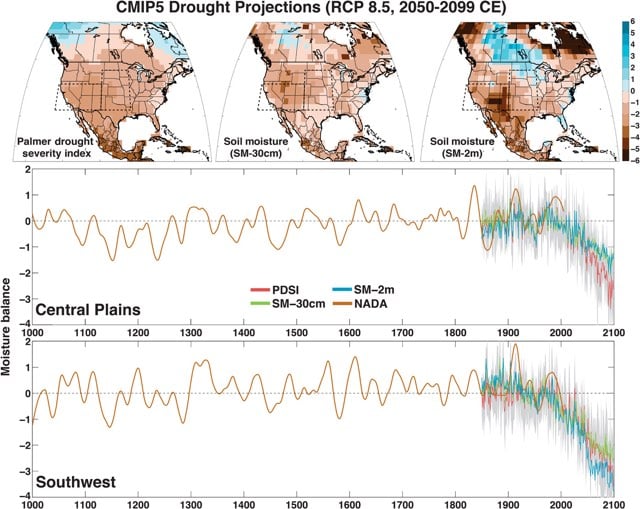The coming American megadrought of 2050

A recent paper by three climate scientists concludes there’s a high risk of an unprecedented drought in the Southwest and Midwest United States later this century, even if we manage to get our carbon emissions under control. The scientists say it’ll be drier in the Western US than at any point in the past 1000 years.
In the Southwest and Central Plains of Western North America, climate change is expected to increase drought severity in the coming decades. These regions nevertheless experienced extended Medieval-era droughts that were more persistent than any historical event, providing crucial targets in the paleoclimate record for benchmarking the severity of future drought risks. We use an empirical drought reconstruction and three soil moisture metrics from 17 state-of-the-art general circulation models to show that these models project significantly drier conditions in the later half of the 21st century compared to the 20th century and earlier paleoclimatic intervals. This desiccation is consistent across most of the models and moisture balance variables, indicating a coherent and robust drying response to warming despite the diversity of models and metrics analyzed. Notably, future drought risk will likely exceed even the driest centuries of the Medieval Climate Anomaly (1100-1300 CE) in both moderate (RCP 4.5) and high (RCP 8.5) future emissions scenarios, leading to unprecedented drought conditions during the last millennium.
Eric Holthaus has the layperson’s explanation of the study and its implications.
Smerdon’s study is the first to examine the future risk of “megadrought” in the southwest and central United States in the context of historical episodes of drought in the same regions. Smerdon’s study suggests that the coming years are likely to see droughts worse than the epic dry periods that are thought to have caused profound changes to human settlement in the region over the last millennium.
“They’re ‘mega’ because they are droughts that lasted in these regions for multiple decades,” said Smerdon in an interview with Slate. “We haven’t seen anything like this since at least the 1400s.” In comparison, the current California drought is four years old, though drought has been present in most of the last 15 years somewhere in the West.
Update: This NASA video provides a quick overview of this study and what it means for our climate.





Stay Connected